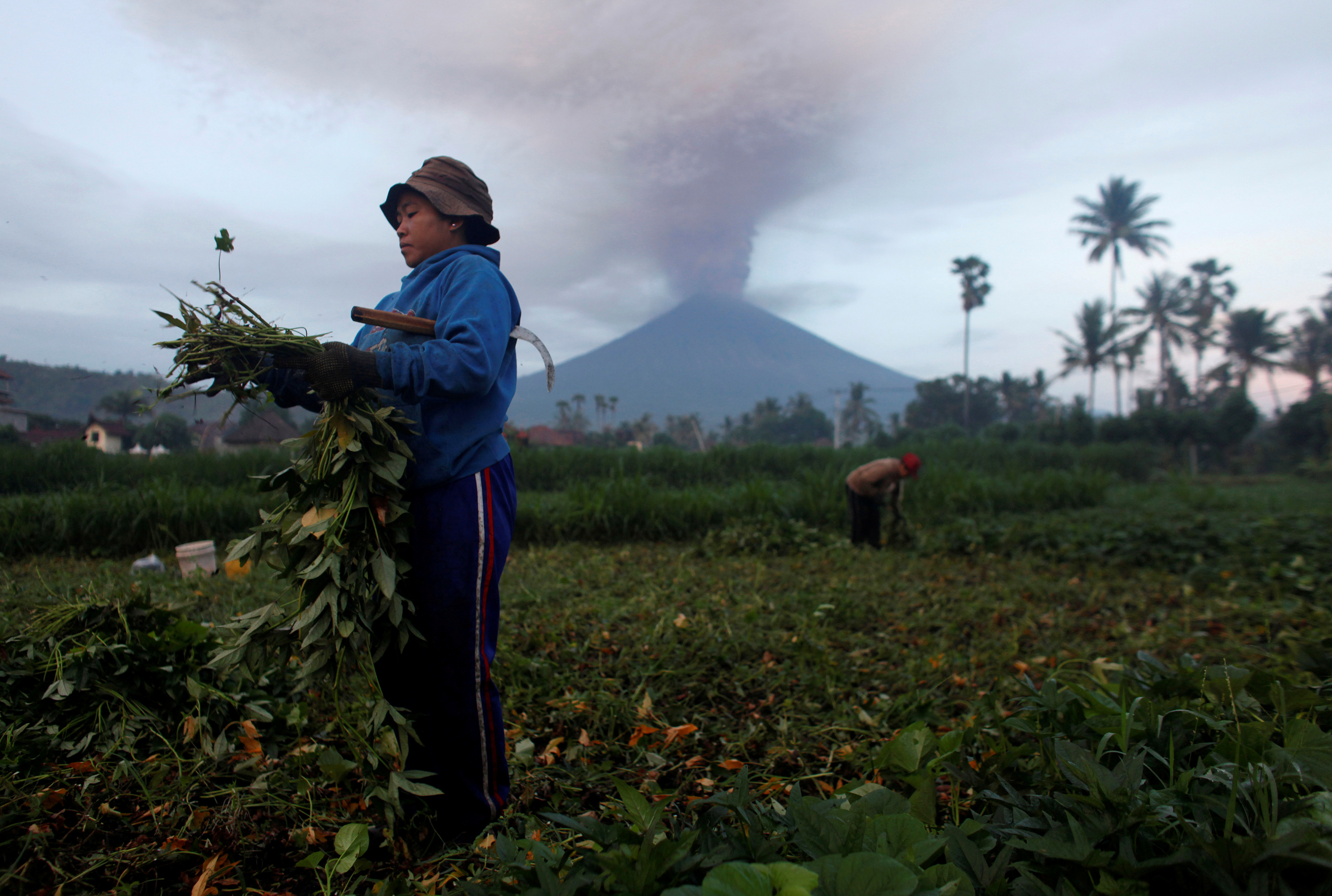
By Nyimas Laula
DENPASAR, Indonesia (Reuters) – Indonesia raised its warning for Bali’s Mount Agung volcano to the top level four alert on Monday, closed the holiday island’s airport and told residents around the mountain to immediately evacuate, warning of an “imminent” risk of a larger eruption.
Bali’s airport was closed for 24 hours from Monday morning, disrupting 445 flights and some 59,000 passengers, due to the eruption and the presence of volcanic ash from Agung, but local officials said the closure could be extended.
Video footage shared by the disaster agency showed cold lava flows (lahar) at a number of locations on the mountainside. Lahar carrying mud and large boulders can destroy houses, bridges and roads in its path.
“Plumes of smoke are occasionally accompanied by explosive eruptions and the sound of weak blasts that can be heard up to 12 km (7 miles) from the peak,” the Disaster Mitigation Agency (BNPB) said in a statement after raising the alert level from three to four.
“The potential for a larger eruption is imminent,” it said, referring to the visible glow of magma at Agung’s peak overnight.
Residents were warned to “immediately evacuate” a danger zone that circles Agung in a radius of 8-10 km (5-6 miles).
Sutopo, a BNPB spokesman, said there had been no casualties so far and 40,000 people had left the area, but tens of thousands still needed to move and warned authorities would move them by force if necessary.
Agung rises majestically over eastern Bali to a height of just over 3,000 metres (9,800 feet). Eastern Bali is relatively undeveloped, with traditional rice paddies doting the landscape and the occasional budget resort, unlike the heavily populated southern tourist hub of Kuta-Seminyak-Nusa Dua.
Agung’s last eruption in 1963 left more than 1,000 people dead and razed several villages.
Analysis suggested the threat should not be as great this time because “energy at Mount Agung’s magma chamber is not as big” and with the ash column only around a quarter as high so far as the 20 km (12 miles) reached in 1963, said Sutopo.
“I’m not worried (but) my friends in Russia are a little bit,” said a Russian tourist, who only wanted to be identified as Dmitry, at an observation post in Rendang in Bali’s east.
Bali, famous for its surf, beaches and temples, attracted nearly 5 million visitors last year, and its international airport serves as a transport hub for the chain of islands in Indonesia’s eastern archipelago.
Tourism business has slumped in Bali since September when Agung’s volcanic tremors began to increase.
TRAVELLERS STRANDED
According to the Volcanic Ash Advisory Centre in nearby Darwin, Australia, there is “ash confirmed on the ground at Denpasar Airport” as well as ash at FL300 (which refers to flight level at 30,000 feet) in the vicinity of the volcano.
Bali’s I Gusti Ngurah Rai airport, which is about 60 km (40 miles) from the volcano, will be closed for 24 hours, according to its operator. A total of 445 flights – 196 international and 249 domestic – and 59,000 passengers had been affected.
Ten alternative airports have been prepared for airlines to divert inbound flights, including in neighbouring provinces.
The airport operator said it was providing buses to take travellers to ferry ports for alternative travel arrangements.
Bali airport’s official website showed flights operated by Singapore Airlines, Sriwijaya, Garuda Indonesia, Malaysia Airlines and Jetstar had been cancelled.
Television footage showed hundreds of holidaymakers camped inside the airport terminal, some sleeping on their bags, others using mobile telephones.
“We have been here (in Bali) for three days we are about to leave today, but just found out our flights have been cancelled. We have got no information because the gates, the check-ins have been closed indefinitely,” said Carlo Oben from Los Angeles.

Farmers tend their crops as Mount Agung erupts in the background in Amed, Karangasem Regency, Bali, Indonesia, November 27, 2017. REUTERS/Nyimas Laula
AIRLINE RISK FROM ASH
Cover-More, Australia’s biggest travel insurer, said on its website customers would only be covered if they had bought policies before the volcano alert was first issue on Sept. 18.
Indonesia’s hotel and restaurant association said stranded tourists at member hotels would get one night’s free stay.
A transport ministry spokesman said the main airport on the neighbouring island of Lombok had reopened after “no volcanic ash was detected”.
Airlines avoid flying when volcanic ash is present because it can cause significant damage to aircraft engines, leading to possible engine failure, and can clog fuel and cooling systems and hamper pilot visibility.
In June 1982, a British Airways 747 suffered severe damage and had all four engines flame out after encountering ash from Mount Galunggung in Indonesia. It descended to 12,000 feet before being able to restart some engines and make an emergency landing in Jakarta.
The alert level on Agung had been raised to the maximum in September, but was lowered in October when seismic activity calmed. However, volcanologists now say the volcano has entered a new phase with magma now visible at Agung’s peak, meaning a greater risk of a larger eruption.
(Additonal reporting by Reuters Bali stringer in DENPASAR, Angie Teo, Fransiska Nangoy and Bernadette Christina Munthe in JAKARTA and Jamie Freed in SINGAPORE; Writing by Ed Davies and Fergus Jensen; Editing by Michael Perry)







